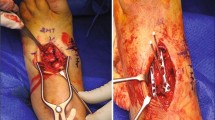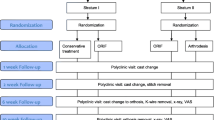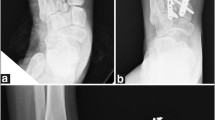Abstract
Background
Open reduction and internal fixation (ORIF) is a popular method for treatment of displaced Lisfranc injuries. However, even with anatomic reduction and solid internal fixation, treatment does not provide good outcomes in certain severe dislocations. The purpose of this study was to compare ORIF and primary arthrodesis (PA) of the first tarsometatarsal (TMT) joint for Lisfranc injuries with the first TMT joint dislocation.
Methods
Seventy-eight Lisfranc injuries with first TMT joint dislocation were finally enrolled and analyzed in a prospective, randomized trial comparing ORIF and PA. They were 50 males and females with a mean age of 40.7 years and randomized to ORIF group and PA group. Outcome measures included radiographs, American Orthopaedic Foot and Ankle Society (AOFAS) midfoot scale, Foot and Ankle Ability Measure (FAAM) Sports subscale, visual analog scale (VAS), and the 36-Item Short Form Health Survey (SF-36). Complications and revision rate were also analyzed.
Results
Forty patients were treated by ORIF, while PA group includes 38 cases. Patients were followed up for 37.8(range, 24–48) months. At final follow-up, the mean AOFAS midfoot score (P < 0.01), the FAAM Sports subscale (P < 0.01), the physical function score (P < 0.05), and the Bodily Pain score of SF-36 (P < 0.05) after ORIF treatment were significantly lower than PA group. The mean VAS score in ORIF group was higher (P < 0.01). In ORIF group, redislocation of the first TMT joint was observed in ten cases, and thirteen patients had pain in midfoot. No redislocation and no hardware failure were identified in PA group.
Conclusion
PA of the first TMT joint provided a better medium-term outcome than ORIF for Lisfranc injuries with the first TMT dislocation. Possible complications and revision could be avoided by PA for dislocated first ray injuries.




Similar content being viewed by others
References
Moracia-Ochagavía I, Rodríguez-Merchán EC (2019) Lisfranc fracture-dislocations: current management. EFORT Open Rev 4:430–444
Welck MJ, Zinchenko R, Rudge B (2015) Lisfranc injuries. Injury 46:536–541
Coetzee JC (2008) Making sense of Lisfranc injuries. Foot Ankle Clin 13:695–704
Haapamaki V, Kiuru M, Koskinen S (2004) Lisfranc fracture-dislocation in patients with multiple trauma: diagnosis with multidetector computed tomography. Foot Ankle Int 25:614–619
Lewis JS Jr, Anderson RB (2016) Lisfranc injuries in the athlete. Foot Ankle Int 37:1374–1380
Albright RH, Haller S, Klein E, Baker JR, Weil L Jr, Weil LS Sr, Fleischer AE (2018) Cost-effectiveness analysis of primary arthrodesis versus open reduction internal fixation for primarily ligamentous Lisfranc injuries. J Foot Ankle Surg 57:325–331
Buda M, Kink S, Stavenuiter R, Hagemeijer CN, Chien B, Hosseini A, Johnson AH, Guss D, DiGiovanni CW (2018) Reoperation rate differences between open reduction internal fixation and primary arthrodesis of Lisfranc injuries. Foot Ankle Int 39:1089–1096
Cochran G, Renninger C, Tompane T, Bellamy J, Kuhn K (2017) Primary arthrodesis versus open reduction and internal fixation for low-energy Lisfranc injuries in a young athletic population. Foot Ankle Int 38:957–963
Coetzee JC, Ly TV (2007) Treatment of primarily ligamentous Lisfranc joint injuries: primary arthrodesis compared with open reduction and internal fixation. Surgical technique. J Bone Joint Surg Am 89:S122–S127
Henning JA, Jones CB, Sietsema DL, Bohay DR, Anderson JG (2009) Open reduction internal fixation versus primary arthrodesis for Lisfranc injuries: a prospective randomized study. Foot Ankle Int 30:913–922
Kirzner N, Teoh W, Toemoe S, Maher T, Mannambeth R, Hughes A, Goldbloom D, Curry H, Bedi H (2020) Primary arthrodesis versus open reduction internal fixation for complete Lisfranc fracture dislocations: a retrospective study comparing functional and radiological outcomes. ANZ J Surg 90:585–590
Ly TV, Coetzee JC (2006) Treatment of primarily ligamentous Lisfranc joint injuries: primary arthrodesis compared with open reduction and internal fixation. A prospective, randomized study. J Bone Joint Surg Am 88:514–520
Stødle AH, Hvaal KH, Brøgger HM, Madsen JE, Husebye EE (2020) Temporary bridge plating vs primary arthrodesis of the first tarsometatarsal joint in Lisfranc injuries: randomized controlled trial. Foot Ankle Int 41:901–910
Hu SJ, Chang SM, Li XH, Yu GR (2014) Outcome comparison of Lisfranc injuries treated through dorsal plate fixation versus screw fixation. Acta Ortop Bras 22:315–320
Ibrahim T, Beiri A, Azzabi M, Best AJ, Taylor GJ, Menon DK (2007) Reliability and validity of the subjective component of the American Orthopaedic Foot and Ankle Society clinical rating scales. J Foot Ankle Surg 46:65–74
Kitaoka HB, Alexander IJ, Adelaar RS, Nunley JA, Myerson MS, Sanders M (1994) Clinical rating systems for the ankle-hindfoot, midfoot, hallux, and lesser toes. Foot Ankle Int 15:349–353
Ware JE Jr, Sherbourne CD (1992) The MOS 36-item short-form health survey (SF-36). I. Conceptual framework and item selection. Med Care 30:473–483
Huskisson EC (1974) Measurement of pain. Lancet 2:1127–1131
Kuo RS, Tejwani NC, Digiovanni CW, Holt SK, Benirschke SK, Hansen ST Jr, Sangeorzan BJ (2000) Outcome after open reduction and internal fixation of Lisfranc joint injuries. J Bone Joint Surg Am 82:1609–1618
Buzzard BM, Briggs PJ (1998) Surgical management of acute tarsometatarsal fracture dislocation in the adult. Clin Orthop Relat Res 335:125–133
Nunley JA, Vertullo CJ (2002) Classification, investigation, and management of midfoot sprains: Lisfranc injuries in the athlete. Am J Sports Med 30:871–878
Mulier T, Reynders P, Dereymaeker G, Broos P (2002) Severe Lisfrancs injuries: primary arthrodesis or ORIF? Foot Ankle Int 23:902–905
Dalal D, Curry C, Carter R, Zdenek C, Todd NW, Rush SM, Jensen R (2018) Surgical treatment of Lisfranc injury with plantar plate approach. J Foot Ankle Surg 57:794–800
Kirzner N, Zotov P, Goldbloom D, Curry H, Bedi H (2018) Dorsal bridge plating or transarticular screws for Lisfranc fracture dislocations: a retrospective study comparing functional and radiological outcomes. Bone Joint J 100-B:468–474
Li CG, Yu GR, Yang YF, Li B (2016) Categorization and surgical management of posttraumatic midfoot malunion. J Int Med Res 44:905–916
Mora AD, Kao M, Alfred T, Shein G, Ling J, Lunz D (2018) Return to sports and physical activities after open reduction and internal fixation of Lisfranc injuries in recreational athletes. Foot Ankle Int 39:801–807
Funding
The authors disclosed receipt of the following financial support for the research, authorship, and/or publication of this article: This work was supported by the Natural Science Foundation of Beijing (No. 7212020), the Science and Technology Planning Project of Beijing Municipal Education Commission (No. KM202110025013), and the Beijing Thousand Talents Project (No. 2020A43).
Author information
Authors and Affiliations
Contributions
All authors contributed to the study conception and design. Material preparation, data collection, and analysis were performed by Chengyi Sun, Mingzhu Zhang, and Xudong Miao. The first draft of the manuscript was written by Chengyi Sun, and all authors commented on previous versions of the manuscript. All authors read and approved the final manuscript.
Corresponding author
Ethics declarations
Ethics approval
This clinical trial was performed in line with the principles of the Declaration of Helsinki and was registered in Clinical trials. org (ID: ChiCTR1800020466).
Conflict of interest
The authors declare no competing interests.
Additional information
Publisher's note
Springer Nature remains neutral with regard to jurisdictional claims in published maps and institutional affiliations.
Rights and permissions
About this article
Cite this article
Sun, C., Miao, X., Zhang, M. et al. Lisfranc injuries with dislocation the first tarsometatarsal joint: primary arthrodesis or internal fixation (a randomized controlled trial). International Orthopaedics (SICOT) 46, 2529–2537 (2022). https://doi.org/10.1007/s00264-022-05478-y
Received:
Accepted:
Published:
Issue Date:
DOI: https://doi.org/10.1007/s00264-022-05478-y




